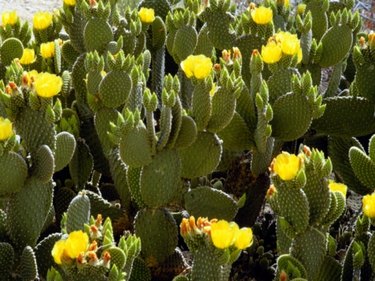Opuntia, or prickly pear cactus, can be found growing naturally throughout the U.S. and can easily be recognized by the large flat platyclades, or pads, covered with spiky thorns. In late spring to mid-summer the prickly pear will bloom yellow flowers that fade to orange. Later, edible fruit develops on the flat pads where the blossoms were. In USDA hardiness zones 8 to 11, prickly pear cactus can be an interesting visual textural plant in landscapes and xeriscapes. Prickly pear cactus also is suitable as an indoor houseplant.

Video of the Day
Things You'll Need
Sand, Pumice Or Perlite
Rocks Or Sticks (Optional)
Long, Sharp Knife
Heavy Gloves, Tongs, Or Layers Of Newspaper
Potting Soil, Peat Or Compost
Step 1
Wear heavy gloves or wrap the prickly pear cactus pad you intend to harvest with several layers of newspaper. Tongs may also be used to handle the cactus pad, which is covered with sharp needle-like thorns.
Video of the Day
Step 2
Use a clean long sharp knife to cut one prickly pear pad from a healthy cactus plant. The cut should be at the node, or joint, of the plant pads. Select a prickly pear pad that is at least six months old to harvest from the healthy mother plant.
Step 3
Allow the cut-off prickly pear pad to dry and develop a callus on the cut end. To develop a callus, place the pad in a warm, dry spot, with the cactus pad flat to let the cut end be exposed to air and dry. It generally takes about one week for the cactus pad cut to dry and develop the callus, but it can take up to a month if the environment is humid. Planting the prickly pear pad without the development of a callus may result in the pad simply rotting instead of growing roots.
Step 4
Insert the cut, callus end of the prickly pear pad into a soil mix that is 50 percent sand, pumice or perlite, and 50 percent potting soil, peat or compost. Mix this combination well before inserting the cactus. The callus end should be inserted about 1 inch into the soil mix. Deeper planting may result in the pad rotting, and planting the pad less than 1 inch creates instability for the pad.
Step 5
Water the newly planted lightly to moisten the planting mix, then do not water it again for one month. The moisture in the pad will be enough to enable the pad to grow roots. After a month these new roots should be sprouted and the pad will be more stable in the potting soil. Allow the prickly pear pad soil to completely dry between watering. Too much water may cause the cactus to rot.
Tip
You may also wish to support the newly planted pad with rocks or sticks for the first month or two, until the pad has developed its own support roots.
Warning
Do not use rotted animal manure as compost in the soil mix. Animal manure contains salts and other elements that inhibit root development. Better to use organic matter such as dried leaves and grass clippings.